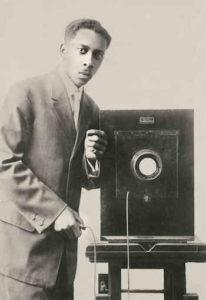
Addison Sculock
Addison N. Scurlock was born on this date in 1883. He was a Black photographer.
Born in Fayetteville, N.C., he graduated from high school there and, in 1900, moved with his family to Washington, D.C. His father, George Clay Scurlock, had run unsuccessfully for the North Carolina Senate. He also worked as a messenger for the U.S. Treasury Department while studying law, and he later opened a law office on the 1100 block of U Street.
Young Scurlock began his career as a photographer apprentice to Moses P. Rice, who had studios on Pennsylvania Avenue. By 1904, he had learned the basics of photographic portraiture and the entire range of laboratory work. That same year, he started his own business at his parents’ home on Florida Avenue.
He photographed students at Howard University, M Street, Armstrong High Schools, HBCU universities, and high schools throughout the South. In 1907, he won a gold medal for photography at the Jamestown Exposition. He opened the Scurlock Studio in the Black community’s theater district in 1911 and concentrated on portraiture and general photography. His clients included brides, successful individuals, politicians, presidents, convention attendees, and socialites. A 1976 Washington Post article by Jacqueline Trescott read, "For years, one of the marks of arriving socially in Black Washington was to have your portrait hanging in Scurlock’s window."
In addition to studio portraits, he mastered the use of the panoramic camera and shot conventions, including banquets and graduations. By the 1920s, he had earned a national reputation. He was the official photographer of Howard University until he died in 1964, and he captured all aspects of the university's life.
Scurlock also produced a series of portraits of African American leaders that historian Carter G. Woodson distributed to Black schools nationwide. One of his most significant photographs was Marian Anderson singing in front of the Lincoln Memorial in 1939.
A famous story is told about him, which involves him walking up to President Coolidge with the Dunbar Cadet Corps on the White House Lawn. He then moved the president to another position for the sake of a better picture, much to the dismay of the Secret Service.
Scurlock and his wife, Mamie Estelle, lived just a few blocks from the studio with their four sons: Addison, Robert, George, and Walter. Mamie served as the studio’s business manager. From 1948 until 1952, Robert and George managed the Capital School of Photography. Among their students were future Washington Post photographers and a young Jacqueline Bouvier, who became the wife of John Kennedy.
As founder of the Scurlock Photographic Studio, he took portraits of such notables as educators Booker T. Washington and Mary McLeod Bethune, composer Samuel C. Taylor, engineer Archie Alexander, political leader W.E.B. DuBois, former first lady Mamie Eisenhower, singer Billy Eckstine, physician Charles R. Drew, opera singer Madame Lillian Evanti, poet Sterling Brown and others while documenting key moments in Washington, D.C. history. In 1964, Robert bought the Scurlock studio from his father and purchased a studio on Connecticut Avenue. Addison Scurlock died on December 16, 1964, at 81.
The Connecticut Avenue studio closed in the early 1970s, and the 9th Street studio was demolished in 1983 for the Metro system.
The African American Atlas
Black History & Culture an Illustrated Reference
by Molefi K. Asanta and Mark T. Mattson
Macmillan USA, Simon & Schuster, New York
ISBN 0-02-864984-2